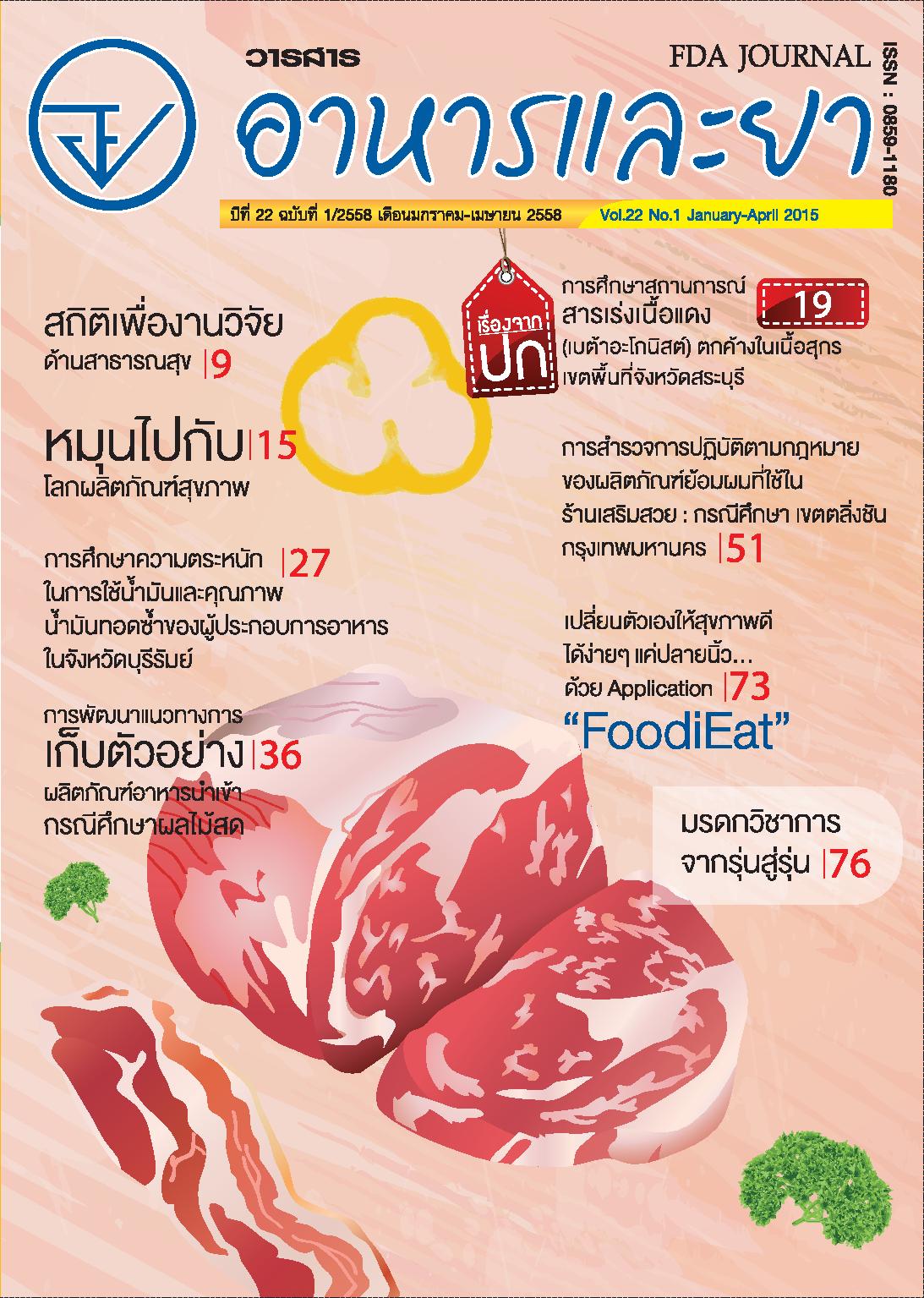การพัฒนาแนวทางการเก็บตัวอย่างผลิตภัณฑ์อาหารนำเข้า กรณีศึกษาผลไม้สด
Main Article Content
บทคัดย่อ
การเปิดเขตการค้าเสรีท�ำ ให้ประเทศไทยมีการนำเข้าสินค้ามากขึ้น ซึ่งผลไม้สดก็เป็นอีกสินค้าหนึ่ง
ที่ประเทศไทยนำ เข้าจากต่างประเทศเป็นจำนวนมาก หากมาตรการควบคุมคุณภาพผลไม้สดนำ เข้าไม่รัดกุม
ผู้บริโภคอาจได้รับอันตรายได้ การศึกษาเชิงพรรณนานี้มีวัตถุประสงค์ เพื่อพัฒนาแนวทางการกำ หนดแผนเก็บตัวอย่าง
ผลไม้สดของด่านอาหารและยาแต่ละด่านโดยประมวลและวิเคราะห์ข้อมูลที่เก็บรวบรวมจากแหล่งข้อมูลต่างๆ
และนำแนวทางที่พัฒนาแล้วมากำหนดแผนการเก็บตัวอย่างผลไม้สดของสำนักด่านอาหารและยาให้สอดคล้อง
กับสากล ข้อมูลที่นำมาใช้ได้แก่ รายงานผลการวิเคราะห์ตัวอย่างผลไม้สดของกรมวิทยาศาสตร์การแพทย์
(ตั้งแต่ปี พ.ศ. 2554-2556) ข้อมูลการนำเข้าของกรมศุลกากร แล้วนำ มาจัดลำดับความเสี่ยงโดยกำหนดปัจจัยเสี่ยง
เป็น 3 มิติ 4 ปัจจัย ได้แก่ มิติด้านระบาดวิทยา ปัจจัยคือ อุบัติการณ์ของผลวิเคราะห์สารพิษตกค้างที่ไม่เข้ามาตรฐาน
ตามประกาศกระทรวงสาธารณสุข เรื่อง อาหารที่มีสารพิษตกค้าง พ.ศ. 2554 มิติด้านผลิตภัณฑ์ ปัจจัยคือ ชนิดของ
สารพิษตกค้างตามประกาศกระทรวงสาธารณสุขฉบับดังกล่าว และลักษณะการรับประทาน มิติด้านการรับสัมผัส
ปัจจัยคือ ปริมาณนำเข้านำคะแนนที่ได้มาจัดแบ่งกลุ่มผลไม้ตามความเสี่ยงได้เป็น 3 ระดับ ได้แก่ เสี่ยงมาก
เสี่ยงปานกลาง และเสี่ยงน้อย แล้วจัดสรรจำนวนตัวอย่างโดยผลไม้ที่เสี่ยงมากเก็บตัวอย่างเป็น 3 เท่า ผลไม้
ที่เสี่ยงปานกลางเก็บตัวอย่างเป็น 2 เท่าของผลไม้ที่เสี่ยงน้อย ผลที่ได้คือ แนวทางกำหนดแผนเก็บตัวอย่าง
ประจำปีที่แบ่งเป็น 4 ไตรมาส แต่ละไตรมาสแบ่งเป็น 3 ระดับของความเสี่ยง จากการประชุมระดมสมองเจ้าหน้าที่
ด่านอาหารและยา จำนวน 20 คนจากด่านอาหารและยาต่างๆ 14 แห่งจากด่านอาหารและยาทั้งหมด 44 แห่ง
ซึ่งได้ข้อคิดเห็นและข้อเสนอแนะสรุปได้ว่า เจ้าหน้าที่ด่านอาหารและยาเห็นด้วยกับแนวทางกำหนดแผน
เก็บตัวอย่างที่ได้ศึกษาซึ่งสอดคล้องกับหลักดำเนินงานสากล เช่น แนวทางของโคเด็กซ์ สามารถนำ ไปใช้เป็น
แนวทางในการจัดทำแผนเก็บตัวอย่างประจำ ปี โดยขยายผลให้ครอบคลุมกลุ่มของผลิตภัณฑ์มากขึ้น อีกทั้งแนวทาง
ดังกล่าวอาจช่วยลดปัญหาการเก็บตัวอย่างที่ไม่สม่ำเสมอ และลดค่าใช้จ่ายในการวิเคราะห์


